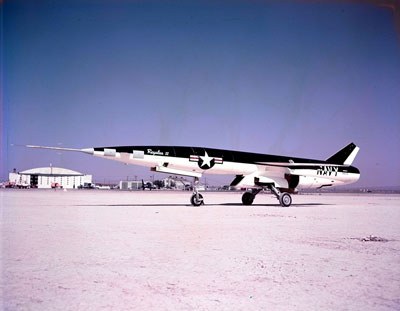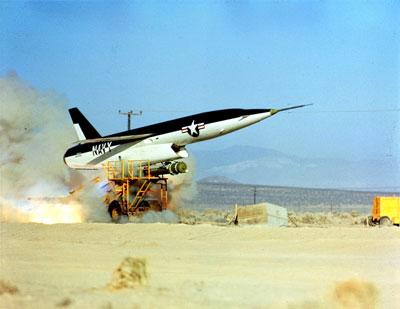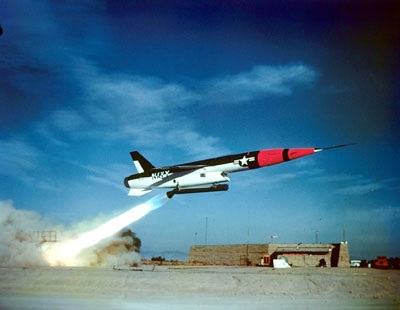Vought SSM-N-9/RGM-15 Regulus II
In June 1953 Vought received a contract to develop a supersonic successor to the SSM-N-8/RGM-6 Regulus cruise missile. The new missile was named Regulus II (although it was a completely new missile, and not a development of Regulus) and received the designation SSM-N-9. The SSM-N-9 designator had been previously assigned temporarily to the MGM-18 Lacrosse missile, before the latter was transferred to the Army as SSM-G-12.
The XRSSM-N-9 Regulus II prototypes had a retractable landing gear for missile recovery, and an interim Wright J65-W-6 engine, which didn't allow flight at the design speed of Mach 2. The first flight of an XRSSM-N-9 occurred in May 1956, and the testing of this model continued until the end of 1957. In 1958 testing continued with the improved XRSSM-N-9a prototypes, which still had the landing gear, but were equipped with the General Electric J79-GE-3 engine intended for the tactical missiles. The first launch of a Regulus II from a submarine occurred in September 1958. The designations YTSSM-N-9a and TSSM-N-9a were reserved for evaluation and production models of the landing gear equipped Regulus II, to be used for training purposes.
 |
| Photo: Vought |
| XRSSM-N-9a |
Regulus II was a Mach 2 cruise missile design, which could also attain a significantly higher altitude and range than the SSM-N-8 Regulus I. The radio command guidance of the Regulus I was dropped in favour of an inertial guidance system, making the SSM-N-9 much less prone to electronic jamming. Despite these advantages, the Regulus II would have been hopelessly obsolete with the advent of the UGM-27 Polaris SLBM (Submarine-Launched Ballistic Missile), and therefore the tactical SSM-N-9 Regulus II cruise missile was cancelled in late 1958. Nevertheless the evaluation of the missile's performance continued, and the first XSSM-N-9 tactical prototype (substituting the landing gear for additional fuel, allowing full range and Mach 2 capability) was launched in November 1959, followed by YSSM-N-9 evaluation models. Interestingly, the SSM-N-9 was redesignated as RGM-15A in June 1963, more than 4 years after the program had been cancelled.
 |
| Photo: Vought |
| XSSM-N-9 (RGM-15A) |
In the final stages of the Regulus II program, around 1958, it was apparently proposed to equip the missile with a radar map matching guidance system. In this system, which is generally known as TERCOM (Terrain Contour Matching), the radar map of the terrain below the missile's flight path is constantly matched with preloaded radar maps, allowing the missile to follow a precise preprogrammed path. For evaluation missiles equipped with this guidance system, the designations YTSSM-N-9b and YSSM-N-9a were allocated to improved YTSSM-N-9a and YSSM-N-9, respectively. However, none of these variants were built.
After program cancellation, the remaining flight test missiles were used as KD2U-1 supersonic target drones by the U.S. Navy and the U.S. Air Force. The latter used the KD2U-1 extensively during testing of the IM-99/CIM-10 Bomarc surface-to-air missile. In June 1963, the KD2U-1 was redesignated as MQM-15A. Late in their career, some runway-launched MQM-15A drones were redesignated as GQM-15A.
 |
| Photo: Vought |
| KD2U-1 (MQM-15A) (note rarely used ventral fin) |
Only 54 Regulus II test missiles were built before production was cancelled.
Specifications
Note: Data given by several sources show slight variations. Figures given below may therefore be inaccurate!
Data for XRSSM-N-9 and XSSM-N-9 (RGM-15A):
| XRSSM-N-9 | XSSM-N-9 (RGM-15A) | |
|---|---|---|
| Length (w/o pitot tube) | 17.52 m (57 ft 6 in); incl. pitot tube: 19.53 m (64 ft 1 in) | |
| Diameter | 1.27 m (50 in) | |
| Wingspan | 6.12 m (20 ft 1 in) | |
| Weight (w/o booster) | 10400 kg (23000 lb); booster: 3170 kg (7000 lb) | |
| Speed | Mach 1.8 | Mach 2 |
| Ceiling | 14300 m (47000 ft) | 18000 m (59000 ft) |
| Range | 550 km (300 nm) | 1850 km (1000 nm) |
| Propulsion | Cruise: Wright J65-W-6 turbojet; 65 kN (14600 lb) Booster: Aerojet General solid-fueled rocket; 511 kN (115000 lb) |
Cruise: General Electric J79-GE-3 turbojet; 69 kN (15600 lb) Booster: Rocketdyne solid-fueled rocket; 600 kN (135000 lb) |
| Warhead | none | W-27 thermonuclear (2 MT) |
Main Sources
[1] Norman Friedman: "US Naval Weapons", Conway Maritime Press, 1983
[2] Bill Gunston: "The Illustrated Encyclopedia of Rockets and Missiles", Salamander Books Ltd, 1979
[3] James N. Gibson: "Nuclear Weapons of the United States", Schiffer Publishing Ltd, 1996
[4] Vought Heritage Website
[5] BuAer Instruction 05030.4A: "Model Designation of Naval Aircraft, KD Targets, and BuAer Guided Missiles", Dept. of the Navy, 1958
Back to Current Designations Of U.S. Unmanned Military Aerospace Vehicles
Back to Directory of U.S. Military Rockets and Missiles
Last Updated: 16 May 2002